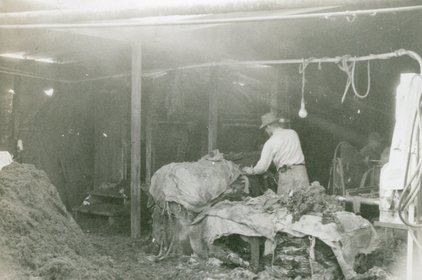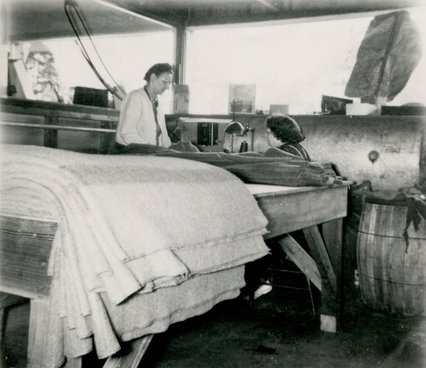Eureka Woolen Mills
|
On exhibit from February 1 - May 6
Early Years of the Woolen Mill During the years from 1890 to 1920, Humboldt County had a very prosperous and rapidly expanding sheep-raising and wool-producing industry. Thousands of sheep were herded in the great ranges in the southern part of the county, the Bald Hills area east of the redwood belt, and in the Eel River Valley. It is safe to say that fully a third of the area of Humboldt County was devoted to the industry with the county exporting 500,000 pounds of wool a year. To capitalize on this booming industry, the Eureka Woolen Mill were constructed in 1901 west of Broadway at the southwest corner of Broadway and 14th Street. Led by A.W. Berr, and backed by John Vance, William Carson, Joseph Russ, and J.W. Henderson, the mill manufactured blankets and flannels, and was able to complete the entire process from wool to finished product and was known for its fine quality. This was a four-set mill powered by two large steam boilers and employed 100 people. In the early 1920s there was a change in ownership and the mill began producing brown army blankets, gray prison blankets, auto robes, and thousands of yards of woolen cloth, which were shipped out of the county to go along with a retail office for local sales. Peak and Decline of the Woolen Mill The Eureka Woolen Mill reached its peak from 1930 through the 1940s with the mill employing 225 workers broken into 3 shifts that worked around the clock. In April, 1949, Victor Egan, who was in charge of sales and shipping departments, left the Eureka Woolen Mills and built a new mill at 4300 Broadway, naming the plant the California Woolen Mills. With the advent of many new synthetic fabrics, such as polyester and nylon, along with cheaper foreign products from Korea, Taiwan and other countries, the demand for woolen products fell off drastically. In addition, the cost of freight became very high and local wages were increasing. All of these factors forced the local mill to close their doors for good in 1966. With no local outlet to sell wool to, many sheep ranchers were forced to sell off their flocks. |


